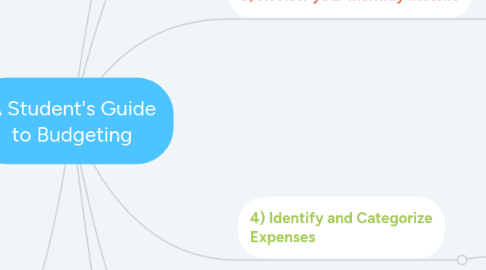
1. 7) Maintain and Update your Budget on a Monthly Basis
2. 6) Balance your Budget
2.1. Compare listed income and expenses(find their balance)
2.1.1. Positive balance: Put extra money towards savings to cover for emergencies or future backups
2.1.2. Negative balance(Over Spending)
2.1.2.1. Monitor your variable expenses, reduce expenses or try to earn more income
2.1.2.1.1. Eg: Eating out less frequently, making your own meals, rent or borrow books rather than buying them, download books from authorised websites, use a shopping list during grocery shopping and buy only what you need, etc.
3. 4) Identify and Categorize Expenses
3.1. Sort all available expenses into fixed and variable expenses
3.1.1. Fixed Expenses: Costs that stay the same for each month
3.1.1.1. Eg: Rent, car payments, insurance
3.1.2. Variable Expenses: Costs that are flexible and can be varied voluntarily
3.1.2.1. Eg: Groceries, clothing, food, entertainment, book supplies
4. 5) Save for Emergencies
4.1. Save and accumulate funds to help deal with unexpected expenses
4.1.1. Ideal amount of a emergency fund usually covers 3 to 6 months of a student's expenses (Bank of America, 2016)
5. 3) Review your monthly income
5.1. Estimate how much money you will receive in a month
5.1.1. Eg: Pocket money from parents, part time jobs, financial aids like scholarships, grants, loans and financial credit balance refunds
6. 2) Choose a tool to help Manage Budget
6.1. Conventional
6.1.1. Record income and expenses using pen, pencil and paper
6.2. Automated
6.2.1. Budgeting apps Eg: Wally, Level Money, GoodBudget, Unsplurge, Mint, etc (Smith,2017)

